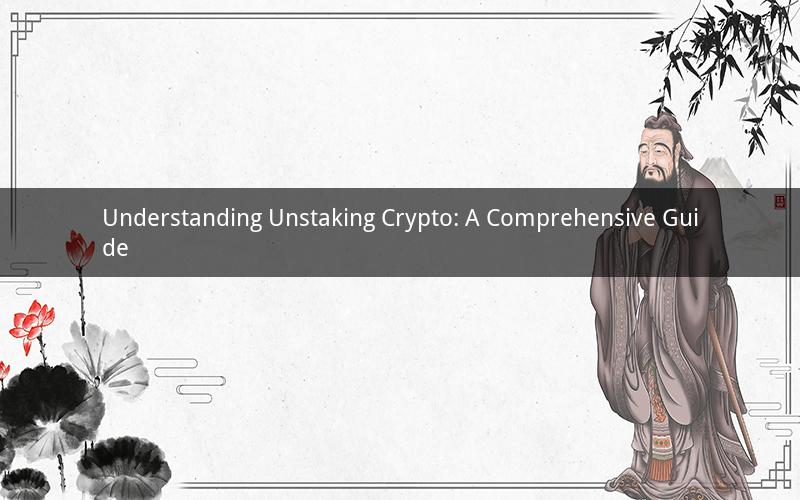
Introduction:
In the world of cryptocurrencies, unstaking has become a crucial process for investors and enthusiasts alike. It refers to the act of withdrawing or removing your crypto assets from a staking pool, thereby ending your participation in the staking rewards program. This guide aims to provide you with an in-depth understanding of what unstaking crypto is, its benefits, the process involved, and potential risks.
What is Unstaking Crypto?
Unstaking crypto is the process of withdrawing your cryptocurrency assets from a staking pool or staking contract. Staking is a way to earn rewards by locking up your crypto assets and participating in the validation process of a blockchain network. By unstaking, you regain control of your assets and can decide how to utilize them further.
Benefits of Unstaking Crypto
1. Flexibility: Unstaking gives you the flexibility to use your crypto assets as you wish. You can sell them, transfer them to another wallet, or use them for other purposes.
2. Reduced Risk: By unstaking, you eliminate the risk associated with staking, such as smart contract failures or network issues that may affect your rewards.
3. Capitalization: Unstaking allows you to capitalize on the market's potential gains. If the price of your crypto asset increases significantly, you can sell it and benefit from the upside.
4. Diversification: By unstaking, you can diversify your portfolio and invest in other assets or projects.
Process of Unstaking Crypto
The process of unstaking crypto may vary depending on the platform or blockchain network you are using. However, the general steps involved are as follows:
1. Log in to your staking wallet or platform.
2. Navigate to the unstaking section or option.
3. Select the crypto assets you wish to unstake.
4. Confirm the transaction and wait for the unstaking process to complete.
It is essential to note that unstaking may take some time, depending on the blockchain network and the amount of assets being unstaked. Some networks may require a minimum unstaking period, while others may allow immediate withdrawal.
Potential Risks of Unstaking Crypto
1. Market Volatility: Unstaking during a volatile market may result in capital loss if the price of your crypto asset declines.
2. Network Fees: Some networks may charge fees for unstaking, which can impact your overall returns.
3. Gas Fees: If you are unstaking through a decentralized platform, you may incur gas fees, which can vary depending on the network's congestion.
Frequently Asked Questions (FAQs)
1. What is the difference between staking and unstaking?
Staking involves locking up your crypto assets to earn rewards, while unstaking is the process of withdrawing your assets from a staking pool or contract.
2. Can I unstake my crypto assets immediately?
The ability to unstake immediately depends on the blockchain network and your staking platform. Some networks may require a lock-up period or minimum unstaking period.
3. How long does it take to unstake crypto assets?
The time required to unstake crypto assets can vary, ranging from a few minutes to several days. It depends on the network's transaction speed and the amount of assets being unstaked.
4. Can I unstake while the market is bearish?
Yes, you can unstake your crypto assets during a bearish market. However, it is essential to consider the potential loss in value and assess your risk tolerance before proceeding.
5. Are there any fees associated with unstaking?
Yes, some networks or platforms may charge fees for unstaking. These fees can vary depending on the network's congestion and the amount of assets being unstaked.
Conclusion:
Unstaking crypto is a crucial process for those looking to regain control of their assets and capitalize on market opportunities. By understanding the benefits, process, and potential risks, you can make informed decisions regarding your crypto investments. Always keep an eye on market trends and network updates to ensure a smooth and successful unstaking experience.